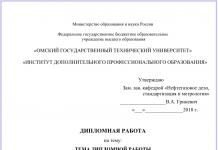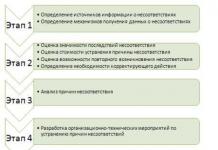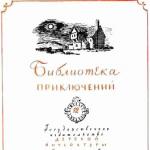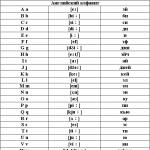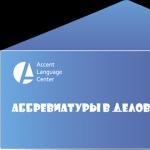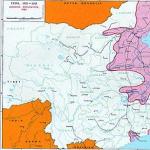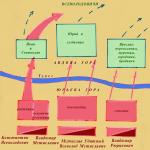Registration of the diploma project according to GOST
The instructions are suitable for preparing diploma and term papers, as well as when preparing abstracts in accordance with GOST.
In fact, in the departments of every educational institution there are teaching aids for students, containing recommendations for design, sometimes even contradicting GOST, but rest assured that the student: “But it’s stated in GOST!” - definitely beats the teacher: “But I should have looked at the training manual!”
Well, let's briefly go through the requirements of this huge document.
General requirements
1. One side of standard A4 paper is allowed to be used; A3 paper is allowed if there are a large number of large tables and illustrations.
2. Type of main text: Times New Roman, 12 or 14 point, regular (not bold or italic), black, indent the first line of the paragraph 1.25-1.5 cm, justified, one and a half spacing.
3. Type of sheet. Page margin indents: left - 3 cm, right - from 1 cm, bottom and top - 2 cm each. Orientation of sheets - vertical, except for the design of large tables and applications. Continuous numbering of pages should be located at the bottom of the sheet, centered or on the right, in 11 point type (pages begin to be counted from the title page, but the number is added only from the introduction).
Heading styling
Headings are the designation of the main parts of an independent study: abstract, content, introduction, analysis of the enterprise, design development, technological calculations, conclusion, list of references.
The chapter headings are formatted as follows: title number (Arabic numerals, without a period after it), text in Times New Roman, 14 point, capital letters, centered.
It is forbidden: use hyphens, underlining, and periods at the end of sentences. Subheadings (paragraphs) are aligned in width, respecting the indentation of the first page, and can be highlighted in bold. There should be one empty line between the title and the text, and 0.8 cm between the title and the paragraph (two spaces).
Table design
The table is inserted immediately after the paragraph mentioning it. The tables are numbered either through numbering or within the boundaries of the section (Table X.U), immediately after the number they put a dash and write its name, which is a multiple and accurately reflects its content. The text of the title is exactly the same as in the text of the work, without paragraph indentation, without a period at the end. If the table has to be moved to the next page, after the head of the table an additional line with column numbering is entered, before continuing the table they write “Continuation of the table X.U)
You cannot end a chapter or paragraph with a table; after it, you must provide a summary of the information presented.
Design of drawings according to GOST
Like a table, a figure should appear below the paragraph in which it is first mentioned. The number and name of the drawing is written below it. Numbering is either within a section or continuous; a dash is placed after the number and the title is written. The title text is the same as in the text of the work, without a period at the end, centered.
Registration of the list of references
The list of used literature should include all sources of information used: books and magazines (in print or electronic form), articles of electronic resources, drawings, etc. The list footnote should include the name of the author, the name of the source and its details (year and city of publication, publisher...). Literature should be numbered and sorted alphabetically by the last names of the authors. If there are documents of different formats in the list, it is customary to first indicate regulatory sources (GOST, SNiP), then author's books, then articles from periodical sources, at the very end of the link to electronic resources.
Do not forget that your professional knowledge is simply wonderful, but without knowledge of such purely bureaucratic subtleties, no one will even undertake to evaluate your knowledge. We wish you good luck in your hard work!
There is some truth in this thought. Members of the State Attestation Commission will not read every page. They will only skim the surface of the diploma. At the same time, it is very important to create a positive impression of the project and please the eye.
In order for the thesis supervisor to sign the thesis in a timely manner, it is important to prepare it in accordance with the requirements of GOST.
The standard that regulates the preparation of theses, like , is only one - GOST 7.32-2001 “System of standards for information, library and publishing. Research report. Structure and design rules” is a companion for any university graduate.
Requirements for the preparation of a thesis according to GOST. General rules
To complete registration in accordance with all laws, you need to meet a number of requirements:
- Use only white A4 paper with a density of 80 g/m2.
- The work must be submitted strictly in printed form on the computer.
- There should be no marks, inscriptions or drawings on the reverse side of the sheet. All work should be on one side.
- , contents, new chapters are drawn up from a new page.
- Field sizes are strictly regulated:
Left 30mm (Spare for fastening);
Right 10mm;
Top and bottom 20 mm. - The sheet orientation is vertical. Horizontal use is allowed, but only for applications, not the main part of the work.
- Aligning the text of the thesis according to width.
- The amount of indentation for a paragraph is not specified in GOST. Therefore, it is best to inquire about this at the department or use an average of 1.25-1.5 cm.
- Only black font is allowed.
- GOST is silent about the need to use a specific font. However, all over the world it is customary to format scientific works in the Times New Roman style; you should not stand out from the crowd.
- Kegel (letter size) - 14.
- The spacing between lines is 1.5.
- Capital letters may only be used in section titles.
- Bold italics may be used to highlight important words or formulas in the diploma.
- Typos are not allowed. As a last resort, you can use a proofreader, but this is only when there is no printer nearby and the work needs to be submitted urgently.
Design of content and headings according to GOST 2018-2019
Rules header design prescribe the following:
- The title should reflect the content of the thesis section;
- For numbering, use only Arabic numbering, do not put a dot after the number;
- If in the text you need to refer to a section of the diploma, then a dot is placed after its number;
- The interval between the title and the main text is 15 mm;
- Subheadings should be placed at paragraph level, and headings should be centered;
- A two-sentence heading should be separated by a period. Transfers are not allowed.
Not a single thesis can do without. It includes all section titles, subheadings, and appendices. It is imperative to indicate the page numbers from which the relevant sections begin. GOST 2018-2019 gives the student the right to decide for himself whether to write names in lowercase or capital letters. But it’s still preferable to use capital letters.
Content design begins by writing the word “Contents” or “Table of Contents” on the first line, centered. Next, the main sections, appendices, conclusion, bibliography are indicated. For each part it is necessary. You should start with three.
There are no criteria for filling the space between the inscription and numbering. If desired, you can decorate it with dots.
The requirements for numbering the thesis are as follows:
- Only Arabic numerals should be used;
- Continuous numbering should be used;
- The title page must be numbered, but a number should not be placed on it;
- The page number is placed at the bottom of the sheet.

Example of a diploma title page
Registration of applications in the thesis
For many scientific disciplines, applications are an important component of scientific and graduate theses. This section usually includes information that for some reason cannot be attached to the main part of the diploma. You can put here:
- Large tables (reference data or technical specifications);
- Empirical formulas;
- Author's methods;
- Illustrations (diagrams, drawings).
When preparing your dissertation applications, you must adhere to the following rules:
- The supplement is a continuation of the diploma; occasionally it can be issued as a separate brochure.
- In the table of contents you need to indicate all applications after the list of references used.
- Applications should be placed and numbered as they are mentioned in the main work.
- Calculations and additional information according to the rules are separated by a sheet on which the word Applications is written in the center.
- All applications should be completed from scratch. Be sure to follow their numbering. After the number, a new line should indicate the topic to which the section is devoted.
- If the text is located on several sheets, then on the second and subsequent pages in the first line they write “Continuation of Appendix No..,” and on the last line – “End of Appendix No...”.
Registration of bibliographic references
- Quoting text from another source;
- Using other people's schemas and tables;
- Research of any work;
- A link to an article where you can read in more detail about the topic covered in the project.
Often used in two ways:
- Interlinear – they are located at the bottom of the page;
- Off-text - numbers in square brackets found throughout the text.
Subscript links are formatted as notes. Along the text with numbering or a marker that will refer the reader to this link. If the marking is in Arabic numerals, then it should be carried out throughout the entire work. You can create your own numbering for each section, or stick to a single one.
Out-of-text references should be formatted as digital marks in the text. This can be either a superscript character or a reference within square brackets. Here the serial number of the literature from the bibliographic list is indicated, separated by a comma, the page number is placed where you can familiarize yourself with the table or text in more detail. Example: .
Registration of the list of references according to GOST 2018-2019
In order to complete your thesis, you must adhere to clear requirements:
- The order in which each
Sometimes you can hear the following phrase: “It doesn’t matter how the diploma is written, it’s important how it’s formatted.” And there really is truth in this statement. Members of the state commission will not read your thesis, they will only skim through it. And it is extremely important that the resulting superficial impression is in your favor!
In order for the state commission to nod their heads approvingly while scrolling through your research, you must strictly comply with the requirements for the design of the thesis according to GOST 2017. In this article, we will dwell in detail on the nuances of the design of the thesis, which are important for both the student and the student.
GOSTs that determine the design of the thesis
Strictly speaking, there is no special GOST 2018 for issuing a diploma. GOST for the design of a thesis has remained virtually unchanged since 2001 (only a small change was made in 2005).
Thus, the current rules for preparing a thesis (2018) are regulated by a document called GOST 7.32-2001 “System of standards for information, library and publishing. Research report. Structure and design rules".
This is a voluminous document, not every bird will reach the middle of it. You can study it yourself, but in this article we will highlight the most important points that should be taken into account when obtaining a diploma in accordance with GOST.
In addition to GOST 7.32-2001, the design of the thesis research is regulated by several other documents. Thus, GOST 7.32-2001 itself is based on almost a dozen GOSTs, the most significant of which for a graduate student are:
- GOST 7.1-2003. System of standards on information, librarianship and publishing. Bibliographic record. Bibliographic description. General requirements and drafting rules.
- GOST 7.9-95 (ISO 214-76). System of standards on information, librarianship and publishing. Abstract and annotation. General requirements.
- GOST 7.12-93. System of standards on information, librarianship and publishing. Bibliographic record. Abbreviations of words in Russian. General requirements and rules.
In addition, when issuing a diploma, other documents are taken into account, for example, GOST 9327-60 (its requirements relate to the design of texts, tables and graphic materials).
Are you afraid that studying these GOSTs will go crazy? Don't worry, there is an easy way to a perfectly designed diploma - reading this article. We have sorted out these terrible GOST standards!
It should be noted that, despite the detailed bureaucratic regulation of the design of scientific research, some minor nuances remained variable. For example, the font type is not specified in GOST, but in practice the rule has long been established to use Times New Roman.
Design nuances that are not specified in GOST, but for some reason required at your department, are indicated in the manual, which should also not be ignored. Be sure that the student’s trump card is “And it is indicated in GOST!” 100% beats with the teacher’s “You should have looked in the manual!”
General requirements for diploma design (page parameters, font, spacing, etc.)
Registration of a thesis according to GOST 2018 implies the fulfillment of mandatory requirements:
1. The paper must be white, standard size A4 (according to GOST 9327), the recommended density is around 80 g/m2. m. In other words, ordinary office paper for printers. (Here and below, Captain Obvious will sometimes take the floor, but it’s better to let him speak out than to screw up something trivially).
Exception: There are cases when GOST allows the use of A3 format when preparing scientific research. This happens when a thesis or other research contains a large number of large tables, illustrations, and drawings. But it is better, if possible, to include them in the Appendices.
2. GOST indicates that the thesis must be submitted in printed form - typed on a typewriter or printed using a computer and printer. A line lower in the document even uses the term PC - personal computer

For a person who is looking for rules for preparing a thesis according to GOST 2018, such a revelation can cause a slight stupor. But let’s not forget that GOST, in fact, has not changed for ten years, and this particular part has not changed for almost fifteen. In those ancient times when this GOST was approved, that is, in 2001, not all students had computers, teachers read handwritten drafts, and there was even a profession of typist on a computer. A little earlier, in the mid-90s, typewriters were widely used for typing, which the compilers of GOST have not yet forgotten. Or, most likely, they simply tore up the wording from the earlier GOST, 7.32-91, with slight changes.
We are sure that next year, when students look for information about preparing a thesis according to GOST 2017, they will again encounter typewriters and personal computers
3. The text should be printed on only one side of the sheet. There should not be any images, marks, etc. on the reverse side. However, the graduate student is no longer a beginner; after a dozen written essays and several coursework, he probably already remembers this.
4. The structural elements of the thesis (introduction, main chapters, conclusion, bibliography, list of footnotes) begin on a new page. Paragraphs/points can also be started on a new page, but the canonical option is to continue on the same page (this point should be clarified with the supervisor or in the manual issued by the department).
Note: Try to keep the end of the chapter at least half the page, or at least a third. The rule is not recorded anywhere, but refers to those unspoken “etiquette” laws that are customarily observed.
5. The width of the margins in the thesis is established by GOST as follows:
— right not less than 10 mm (1 cm);
— left not less than 30 mm (1 cm), reserve is given for stitching;
- top not less than 20 mm (2 cm);
- lower - at least 20 mm (2 cm).
It is interesting that, despite the wording “no less,” in most cases this instruction is interpreted by scientific supervisors as “exactly” or even “no more.” They can be understood: students sometimes abuse wide margins.
6. Sheet orientation – vertical (portrait). Horizontal orientation (landscape) is allowed when designing applications, but not the main part of the thesis.
7. Text alignment in modern dissertations is usually done according to width. GOST does not regulate this point, therefore, in theory, you can align the text to the left (but, of course, not to the right or center). However, in the age of computer technology this will look strange. Again, let’s remember when this GOST was written (based on the even more ancient GOST 7.32-91): in those days when typewriters had not yet become one hundred percent antiques. On a typewriter, even when placing hyphens, it is very difficult to achieve high-quality alignment. And the compilers of these valuable instructions apparently considered this requirement to be an overly stringent requirement. But you have a PC or laptop, right?
We’ll talk about the alignment of chapter headings and subparagraphs in more detail below; there are some nuances there.
8. Paragraph indentations are required, and not according to GOST, but according to the rules of the Russian language. In GOST you should look for instructions regarding its value. But what do we see? The requirements of GOST 2.105-95 regarding the paragraph indentation value of 15 or 17 mm have disappeared in GOST 7.32-2001. In other words, you can make any indentation... within reason, of course. A paragraph indent of 1.25 - 1.5 cm is considered reasonable. And this is the case when it makes sense to inquire about the recommendations of the department.
9. The font color in the thesis is black. There should be no color highlights in the text in the thesis - this is not Lirushechka.
10. What font should I use? GOST is mysteriously silent, but in widespread practice (both domestic and foreign) scientific works are printed in Times New Roman. This is, in fact, an already established standard.
Question: Can I use other fonts in my thesis? In this regard, GOST deigns to provide the following details: yes, individual formulas and terms can be written in other fonts that differ from the font of the main text.
“It is allowed to use computer capabilities to focus attention on certain terms, formulas, theorems, using fonts of different typefaces.”
Source:
Moreover: GOST allows you to enter formulas and other parts of the text by hand that cannot be entered by typewriting. For this, either black ink or black ink is used. It is necessary to write in printed characters. But, in our opinion, for a student applying for a diploma according to GOST in 2018, this freedom is unacceptable. Modern computer technologies make it possible to display any formulas. If there are no suitable symbols, formulas are now inserted as images.
11. The size of the letters, according to GOST, must be no less than twelfth. In practice, graduates use 12 and 14 point Times New Roman font. In footnotes, in captions to tables and images, you can use a smaller point (up to 10).
12. Line spacing, unlike font, is regulated by GOST. It should be one and a half.
13. CAPS LOK is allowed when writing the titles of chapters of the thesis. DO NOT USE IT ANYWHERE ELSE!
14. To highlight the structural parts of the work, that is, in headings and subheadings, you can use bold font. It can also be used to highlight some important phrases and terms - but without enthusiasm. The same goes for italics. For example, you can highlight the words “hypothesis, subject, object, goals, objectives” in bold or italics.
15. Typos are not allowed. If you do find typos, slips, or graphic inaccuracies while proofreading your thesis, then, according to GOST, you can paint them over with white paint (a proofreader is used for this) and carefully make corrections on top so that the blots are not noticeable. But this, gentlemen, students, is an emergency option - for example, if you decide to re-read your diploma right at the university before submitting it to the reviewer and you do not have time to run to the printer. In general, these days, printing out a thesis is not difficult, so make corrections on the computer and reprint the necessary sheets.
Formatting headings in the thesis
The design of headings and subheadings should be discussed separately, because GOST is quite intricate in this matter. The rules are as follows:
- Headings are considered to be the names of the structural parts of the work, representing a brief and clear reflection of the content of sections, subsections, and paragraphs.
- Arabic numerals should be used for numbering.
- When numbering sections, subsections and paragraphs, there is no dot after the numbers.
- When using the wording “part such and such” or “chapter such and such”, a period is placed after the number.
- When numbering sections, subsections, paragraphs, the following rules should be followed:

However, theses do not go to such extremes, so you can forget about letters and numbers with brackets.
- The distance between the text and the heading is not regulated by GOST, but, according to established rules, it is 15 mm, i.e. one confused line with one and a half spacing. The chapter heading is usually separated from the subsection/paragraph heading by 8 mm (double spacing).
- Headings are printed, according to GOST, in capital letters. CAPS LOCOM, IN BRIEF
- Headings are centered, subheadings are indented.
- If the title consists of two sentences, they are separated by a period.
- Hyphenations in headings are not allowed.
- Headings can be bolded, but not underlined.
- There is no period at the end of the title.
If you are interested in the design of a thesis according to GOST 2018, here is a sample of headings:

But this option is used if parts (chapters) are not highlighted in the study. Since chapters are highlighted in the thesis, it is necessary to put a period after the number in the title: “Chapter 1. FROZEN RULES OF DESIGN ACCORDING TO GOST.” Further, dots are no longer added in the numbering of subsections.

There is also an option when a paragraph sign (§) is used to highlight subsections, but this is considered obsolete. Roman numerals are often used to number chapters. There are other options at individual departments, according to the principle “every hut has its own rattles.” But now you know how to act according to GOST, and variations are the responsibility of your supervisor.
Page numbering and content layout
The thesis must include content that indicates all structural parts, including applications. How to write names - lowercase or capital? Unlike GOST 2.105-95, the newer GOST 7.32-2001 leaves the solution to this issue at the discretion of the author.
An example of content formatting in a thesis:

Let's touch on one more GOST nuance. Students who decide to study GOST 7.32-2001 on their own can mess up by following the following instructions:
5.4.2 When preparing a report consisting of two or more parts, each of them must have its own content. In this case, the first part contains the contents of the entire report indicating the part numbers, and the subsequent parts contain only the contents of the corresponding part. It is allowed in the first part, instead of the content of subsequent parts, to indicate only their names.
Department of Education, Science and Youth Policy
Voronezh region
state budget Professional
educational institution of the Voronezh region
"Voronezh State Industrial and Humanitarian College"
Guidelines
by o FORM Yu
theses
and projects
VORONEZH

2017
BBK 74.56
M54
Published by decision of the methodological council
Voronezh State
Industrial and Humanitarian College
Compiled by: N. G. Afanasyeva, O. V. MOISEEVA, R. I. OSTAPENKO,I. N. Strokova, N. R. Podobedova
M54
Guidelines by design theses and projects / Department of Education, Science and Youth. politicians Voronezh. region, Voronezh. state industrial-humanitarian college; [crest: N. G. Afanasyeva, O. V. Moiseeva, R. I. Ostapenko, I. N. Strokova, N. R. Podobedova]. – 7th ed., rev. and additional – Voronezh: VGPGK, 2017. – 27c.
The requirements for the design of the text part, illustrations, tables, links are set out based on GOST 7.32–2001 “Report on scientific research work” with amendment No. 1. Examples are givendescriptions of the output data of sources in accordance with GOST R 7.0.5–2008 “Bibliographic reference. General requirements and rules of compilation."
BBK 74.56
Afanasyeva N. G., Moiseeva O. V., Strokova I. N., Ostapenko R. I.,
Podobedova N. R., 2017
Voronezh State
industrial-humanitarian
college, 2017
GENERAL REQUIREMENTS
The final qualifying work (GQR) is carried out in the form of a graduation project or thesis.
The structure of the diploma project consists of an explanatory note and a graphic part. The thesis consists of a theoretical and practical part.
The final qualifying work must be completed in print using a computer and printer or on a typewriter on one side of a sheet of white A4 paper (210 297 mm). The quality of printing must be high: contrast and clarity of letters, lines, numbers and symbols throughout the text.
Typos and graphic inaccuracies can be carefully painted over with correction fluid. Corrections are made with black ink, paste or ink.Damage to sheets of text, blots and traces of incompletely removed text (graphics) are not allowed!
Abbreviations of words and phrases must correspond to those generally accepted in Russian spelling and punctuation.
Names, designations and units of physical quantities are given in accordance with GOST 8.417–2002 “Units of quantities”, which prescribes the mandatory use of units of the International System of Units (SI).
Abbreviations in the list of used sources in the VKR are given in accordance with GOST R 7.0.12–2011 “Bibliographic record. Abbreviations of words and phrases in Russian. General requirements and rules"
The title page and the assignment for the thesis are drawn up according to the standards established in the college, which are issued by the departments.
The fully completed final qualifying work is bookleted and submitted to the department within the established time frame.
Computer typing options
Body text style:
paper size A4 (210 × 297 mm),
margins: top and bottom – 2 cm each, right – at least 1 cm, left – 3 cm,
font Times New Roman, size 14,
one and a half line spacing,
paragraph indent 1.25 cm,
text alignment, hanging line control,
the maximum number of consecutive transfers is 4,
automatic spell checking.
The structural elements of the thesis: introduction, sections, conclusion, list of sources used, appendices - are located on a new page.
Numerical values from units of measurement are separated by a non-breaking (hard) space:Ctrl + Shift+ space. There are also non-breaking spaces between the two initials and between the initials and the surname.
Pagination: The explanatory note of the thesis project or sections of the thesis and application have a common (end-to-end) numbering in Arabic numerals without a dot, in the center at the bottom of the sheet, the page number size is 12 points.
The title page and the assignment for the thesis are included in the general page numbering, but the page number is not indicated on them. Numbering starts from the third page - from the contents.
Illustrations and tables located on separate A4 sheets are included in the overall numbering. Illustrations made on A3 sheet are counted as one page.
Table style: font TimesNewRoman, size 12, regular, single line spacing. The table head can be set to 10 points.
Style of headings of sections, subsections and paragraphs: font Times New Roman, size 14, without paragraph indentation. Section headings are in bold lowercase letters, subsections and paragraphs are in regular lowercase letters.
Formula set style: normal, large index 7 points, small index 6 points, large symbol 20 points, small symbol 12 points. Central location. Formulas are separated from the text by a blank line at the top and bottom.
Numbering sections, subsections, paragraphs,
subparagraphs, illustrations, tables
Numbering can be continuous (ordinal) - through the entire work - or indexing - acrosssections. Numbers are indicated in Arabic numerals without a dot and are written with paragraph indentation. When indexing numbering, the number of a subsection, item (table, illustration) consists of the section number and the serial number of the subsection, item (table, illustration), separated by a dot. Points, if necessary, can be divided into sub-points, which are numbered within the point.
Example.
4 Requirements for text documents
4.1 Construction of tables
4.1.1 It is allowed to number tables within a section.
If a section (subsection) consists of one subsection (clause), then the subsection (clause) is not numbered.
Listings may be provided within clauses or subclauses. Before each element of the enumeration, a hyphen is placed in paragraph indentation, and if it is necessary to refer in the text to one of the elements of the enumeration, lowercase letters with a parenthesis are used instead of a hyphen (with the exception of the letters е, з, й, о, х, ъ, ы, ь). For example:
A) ____________;
b) ____________.
To further detail the transfers, Arabic numerals are used, followed by a parenthesis:
- amount of tax deductions:A) ____________.
1) ____________;
2) ____________.
If the WRC uses one figure or one table, then they are designated “Table 1”, “Figure 1”.
Tables and illustrations in the appendix are numbered in Arabic numerals with the addition of a letter in front of them indicating the appendix, separated by a dot, for example: Table B.1, Figure A.1.
headers structural elements
Headings of sections, subsections, paragraphs are typed in lowercase letters (except for the first capital) with a paragraph indent, without a period at the end. They are separated from the text at the top and bottom by a blank line.Hyphens and underscores are not allowed in them!
Section headings are written in bold, subsections – in regular type (italics are not used in them).
Example.
1 Accounting for materials in the warehouse
If the title is multi-line, then all lines are typed withparagraph indentation. For example:
1.1 Documentation of receipt of materials
from suppliers
You cannot leave one subsection or paragraph heading at the end of the page; There must be at least 3 lines of text underneath!
Headings of structural elements such as " Contents", "Introduction", "Conclusion", "", "Appendix " are typed in the center in capital letters, without a dot at the end or underscore. They are separated from subsequent text by a blank line.
The content should be formatted as a table of two columns without borders. In the first column - the largest - the headings are typed, in the second - small - the page numbers.
Page numbers are typed right aligned so that the ones are under the ones, the tens are under the tens, etc.
Example.
The use of automated content design is allowed. To do this, you need to select the desired style for the headings of sections and subsections and, upon completion of work on the text of the VKR, insert an automatic table of contents. The font of the table of contents must meet the requirements for the text of the ICR (Times New Roman, size 14, one and a half line spacing, bold for section headings and normal for subsection headings). Paragraph indentations in the content are not allowed.
For computer engineering students, an automatic table of contents is a mandatory element of project design.
Introduction
1 Basic approaches to considering management communication
1.1 Structure and functions of management communication
1.2 Genres of communication between a manager and subordinates
1.3 Leader’s speech culture as an ethical management factor
2 Management communication at OJSC ReKom
2.1 Brief characteristics of ReKom OJSC
2.2 Organization of a communication system in the management process
2.3 Overcoming psychological barriers in the communicative behavior of a subordinate
3.1 Optimization of the communication system in the management process
3.2 Introduction of innovative management mechanisms at OJSC ReCom
Conclusion
List of sources used
Appendix AJob description of the manager of OJSC "ReCom"
Appendix BHierarchy of communications at OJSC ReCom
Illustrations
Illustrations should be used only when they complement, reveal or clarify verbal information. It is not allowed to duplicate the content of the illustration in the text. All illustrations must have links.
In theses, you can use different illustrations: drawings, graphs, diagrams, diagrams, which must meet the requirements of state standards of the Unified System of Design Documentation (ESKD), as well as photographs, computer printouts. In the explanatory note they are all called drawings. It is allowed to make drawings, graphs, diagrams, diagrams using computer printing. Photographs smaller than A4 size must be pasted onto standard sheets of white paper using only PVA glue.
Figures should be placed after a reference to them (for example: ... in accordance with Figure 2) at the end of a sentence or paragraph. If the picture does not fit after the link on the current page, it is allowed to move it to the beginning of the next page. The picture is separated from the text below and above by a blank line. The word “Figure” and its name are placed in the middle of the line. Illustrations may have explanatory information that is placed before the word “Figure”.
Sh 
The width of the drawings should not exceed 17 cm. The recommended height of small drawings (graphs, diagrams) is 6–8 cm, medium ones (diagrams, drawings) are 9–10 cm. Large drawings are located on a separate page, cross-sectional drawings and tables are facing the outer margin on even pages, to the inner margin on odd pages.
Cross-sectional illustration Cross-sectional table
Tables
The width of the table should not be larger than the set format; to do this, you need to selectAutomatic selection of table according to window width .
Tables are usually framed by lines. Horizontal and vertical lines delimiting the rows of the table can be omitted if their absence does not make it difficult to use the data.
The name is placed above the table on the left, without indentation, on one line with its number separated by a dash.
Table ____ - _________________
number table name
Head
Headings graph
Subheadings graph
Strings
Number line
Outset
Column (columns)
When moving a multi-line table to another page, the bottom line delimiting the first part of the table is not drawn. Above the other part on the left, write the words “Continuation of the table” and indicate the table number.
Table 3 - Cost of products
In rubles
Nameproduct
Price 1 kg of product
Top grade
First grade
Second grade
Third grade
Fish
Bird
Continuation of table 3
In rubles
Nameproduct
Retail price of 1 kg of product
Top grade
First grade
Second grade
Third grade
Meat
Flour
If the rows and columns of the table go beyond the page format, then the sidebar is repeated:
Nameproduct
Retail price of 1 kg of product
Top grade
First grade
Second grade
Third grade
Fish
Bird
Continuation of table 3
In rubles
Nameproduct
Wholesale price of 1 kg of product
Top grade
First grade
Second grade
Third grade
Fish
Bird
If the text repeated in different lines of the column consists of one word, then after the first writing it can be replaced with closing quotation marks (), if it consists of two or more words, then at the first repetition it is replaced with the words “The same”, and then with quotation marks, for example :
Same
If there are horizontal lines, the text is repeated!
Incandescent light bulb ania
Incandescent light bulb ania
It is not allowed to put quotation marks instead of repeating numbers, marks, signs, mathematical and chemical symbols.
Instead of missing data, an ellipsis (...) or the words No information are placed, and when there cannot be any data at all, a dash (–) is placed.
Headings of columns and table rows are written with a capital letter in the singular, and column subheadings are written with a lowercase letter if they form one sentence with the heading, or with a capital letter if they have an independent grammatical meaning. All words in the graph headings are given without abbreviations. There are no periods at the end of headings and subheadings of tables.
Column headers are usually written parallel to the table rows. If necessary, perpendicular arrangement of column headings is allowed.
If the table is interrupted at the end of the page and will be continued on the next page, in the first part of the table the lower horizontal line delimiting the table is not needed.
The column “Sequence number” is not allowed to be included in the table. If it is necessary to number indicators, parameters or other data, serial numbers are indicated in the side of the table before their names. For example:
In rubles
Nameproduct
Wholesale price of 1 kg of product
Top grade
First grade
Second grade
Third grade
1. Fish
2. Bird
Before numerical values of quantities and designations of types, brands, etc. Serial numbers are not indicated.
If all the indicators given in the columns of the table are expressed in the same unit of physical quantity, then its designation is placed above the table on the right, and when dividing the table into parts, above each part.
If most of the columns of the table contain indicators expressed in the same units of measurement, but there are columns with indicators expressed in other units, then the name of the predominant indicator and the designation of its physical quantity should be written above the table, for example, and in the subheadings of the remaining columns should be given names of indicators or designations of other units of physical quantities. For example:
Dimensions in millimeters
D atL 1
L 2
L 3
Weight, kg, no more
It is recommended to type the headings of private (Total) and general totals (Total) in capital letters and aligned to the right. For example:
There is no colon after them!
Formulas and equations
Equations and formulas should be highlighted from the text on a separate line, placed in the center. One blank line should be left above and below each formula or equation.
It is permissible to carefully complete formulas and equations in handwriting using black ink, a ballpoint or black gel pen. The height of the characters must be the same as the font size of the text of the work.
Example.
A = a : b .
b = c ∙ d .
If the equation does not fit on one line, it must be moved first after the equal sign (=), then after the plus (+), minus (–), multiplication signs ( or ), division (: or /) or other mathematical symbols, and the symbol at the beginning of the next line is repeated. When transferring a formula to the multiplication sign “dot in the middle” (∙), the “slash cross” sign (×) is used.
An explanation of the meaning of symbols, numerical coefficients and values should be given directly below the formula in the same sequence in which they are given in the formula.
Numbering of formulas is serial in Arabic numerals in parentheses in the extreme right position on the line, for example:
 (1)
(1)
Where TO at – financing ratio;
M - own funds;
TO – borrowed funds, rub.;
Z – accounts payable, rub.
If there is only one formula, it is designated by number one, for example: (1).
Formulas in appendices are numbered separately from the main text within each appendix with the addition of the appendix designation before the number, separated by a dot, for example: (B.1).
Numbering of formulas within a section is allowed: section number and serial number of the formula, separated by a dot, for example: (3.1).
Notes and footnotes
Notes are given if explanations or reference data are needed for the content of the text, tables or graphic material.
Notes should be placed after the text, graphic material or table to which they relate.
The word “Note” should be capitalized from the paragraph and not underlined.
If there is only one note, then a dash is placed after the word “Note” and the note is printed in capital letters. One note is not numbered. Several notes are numbered in order using Arabic numerals without a period. For example:
Notes
1 _________
2 _________
Table notes are placed at the end of the table above the line indicating the end of the table.
Footnotes It is allowed to use additional explanations if necessary (quotes, definitions from various sources, formulas taken from sources, examples, statistical data).
The footnote sign is placed immediately after the word, number, symbol, sentence to which an explanation is given. The footnote sign is performed in superscript Arabic numerals with a parenthesis. It is allowed to use asterisks “*” instead of numbers. More than three stars are not allowed on a page.
The footnote is placed at the end of the page with a paragraph indent, separated from the text by a short horizontal line to the left.
A table footnote is placed at the end of the table above the line indicating the end of the table.
List of sources used
The list must contain information about the sources used in performing the research and development work. Information about sources is provided in accordance with the requirements of R 7.0.5–2008 “Bibliographic reference. General requirements and rules of compilation."
The bibliography is located at the end of the work. First of all, regulatory acts are given in this order: international legal acts, the constitution (if applied), all used codes (first of all, existing ones, then draft and repealed codes), then federal laws (in the same order), then presidential decrees, government regulations, local laws and other regulations, resolutions of the Supreme Council of the Russian Federation. The following are books and publications from periodicals and articles. They must be arranged strictly alphabetically.
At the location of bibliographic references, it is recommended to usebehind-the-text links. A brief reference to an out-of-text reference is made in the text immediately after the end of the quotation or presentation of someone else’s thought, and a detailed description of the source’s output is given in the list of references at the end of the paper. The reference number is enclosed in square brackets. For example: where the first digit is the number in the bibliography, after the number is the abbreviated designation of the page indicating the number.
If the text contains a complex reference (to several sources), then the data is separated by a semicolon. For example: .
When creating a list of sources used, pay attention to the entry of a dash (this symbol is often incorrectly replaced with a hyphen). You can type a dash using the keyboard shortcut Ctrl + Num - (the “-” key should be pressed on the right side of the numeric keypad). This punctuation mark must also be separated by spaces on both sides.
Examples of description of SOURCE OUTPUT DATA
Official, s legislative materials
Constitution of the Russian Federation: official text. – M.: Eksmo-Press, 2015. – 32 p.
Civil Code of the Russian Federation. Part four from December 18. 2006 No. 230-FZ: adopted by the State. Duma Feder. Collection Ross. Federation 24 Nov. 2006: approved. Federation Council Feder. Collection Ross. Federation 8 Dec. 2006: introduction. Feder. Russian law Federation from December 18. 2006 No. 231-FZ // Parliament. gas. – 2006. – December 21.
On state forensic activity in the Russian Federation: federal. law // Vedomosti Feder. Collection RF. – 2001. – No. 17, art. 940. – pp. 11–28.
About the federal budget for 2005: federal. law // New laws and regulations. – 2005. – No. 3. – P. 4–43.
On countering terrorism: federal. Russian law Federation dated March 6, 2006 No. 35-FZ: adopted by the State. Duma Feder. Collection Ross. Federation 26 Feb. 2006: approved. Federation Council Feder. Collection Ross. Federation March 1, 2006 // Ross. gas. – 2006. – March 10.
Regulatory acts
On the procedure for considering candidates for the position of senior official (head of the highest executive body of state power) of a constituent entity of the Russian Federation: decree of the President of the Russian Federation // Ros. gas. – 1997. – November 26. – P. 7.
On the fight against international terrorism: State Decree. Federal Duma. Collection RF // Collection. Russian legislation Federation. – 2001. – No. 40, art. 3810. – pp. 8541–8543.
Federal target program “Destruction of chemical weapons stockpiles in the Russian Federation”: approved. Decree of the Government of Russia. Federation of March 21, 1996 No. 305: as amended. resolutions of the Government of Russia. Federation from 24 Oct. 2005 No. 639 // Collection. Russian legislation Federation. – 2005. – No. 44, art. 4563. – pp. 12763–12793.
On amendments to Article 30 of the Law of the Nenets Autonomous Okrug “On the Civil Service of the Nenets Autonomous Okrug”: Nenets Law. auto env. dated May 19, 2006 No. 721-OZ: adopted Collect. deputies of Nenets. auto env. May 12, 2006 // Naryana vynder (Red tundra) / Collection. deputies of Nenets. auto env. – 2006. – May 24.
German M. Yu. Modernism: art of the first half of the 20th century. – St. Petersburg. : ABC-classics, 2003. – 480 p.
Vlasov A. A. Labor law: lecture notes. – 5th ed., revised. and additional – M.: Yurayt, 2014. – 191 p.
Pakhomov V.I., Petrova G.P. Logistics. – M.: Prospekt, 2006. – 232 p.
Bogataya I. N., Kuznetsova L. N. Office work and accounting: educational and practical work. allowance. – 2nd ed., rev. and additional – M.: Delo, 2003. – 360 p.
Bolshakov A. V., Grekhnev S. V., Dobrynina V. I. Fundamentals of philosophical knowledge: a course of lecturesfor students specialist. textbook establishments /Scientific method. middle center prof. education Ros. Federation. – M.: NMTsSPO, 1997. – 228 p.
Chernik D. G., Pochinok A. P., Morozov V. P. Fundamentals of the tax system: textbook. for universities. –3rd ed., revised. and additional – M.: UNITY-DANA, 2002. – 517 p.
Book by four or more authors
Installation, technical operation and repair of electrical and electromechanical equipment: textbook. allowance / N. A. Akimova, N. F. Kotelenets, N. I. Sentyurikhin [and others]. – 5th ed. – M.: Masterstvo, 2008. – 296 p.
Electrical radio measurements: textbook / V. I. Nefedov, V. I. Khakhin, E. V. Fedorova [etc.]; edited by A. S. Sigova. – M.: FORUM: INFRA-M, 2004. – 384 p.
Book entitled
Criminal law of foreign countries/ ed. G. A. Esakov,N. E. Krylova, A. V. Serebrennikova. – M.: Yurayt, 2013. – 336 p.
Collections
Collection of judicial and arbitration practice: letters, information. letters to the Supreme arbitration. courts of Russia Federations, 2000–2003 / comp. V.N. Bolotsky, L.V. Sotsura; edited by A. A. Bezuglova. – M.: Anthea, 2003. – 591 p.
Article from the collection
Astafiev Yu. V. Judicial power: federal and regional levels / Yu. V. Astafiev, V. A. Panyushkin // State and local authorities: Legal problems: collection. scientific tr. – Voronezh, 2000. – P. 75–92.
Article in a magazine in one issue
Efimova T. N., Kusakin A. V. Protection and rational use of wetlands in the Republic of Mari El // Problems of regional ecology. – 2007. – No. 1. – P. 80–86.
Sokolova I. N. Features of calculating income tax for individuals // Taxes and taxation. – 2004. – December. – P. 55–60.
Article in a magazine in several issues
Alekseev A. Racing with civilization // Science and life. – 2004. – No. 9. – P. 10–17; No. 10. – pp. 58–65.
Newspaper article
Archival documents
OR RNB. F. 316. D. 161. L. 1.
RO IRLEY. F. 568. Op. 1. No. 196. L. 18–19 vol.
Personal file of P. I. Boldin // TsGAIPD. F. 1728. Unit. hr. 537079
Rozanov I. N. How the library of the Historical Museum was created: report. at a meeting of the Academic Council of the State. publ. ist. libraries of the RSFSR June 30, 1939 // GARF. F. A-513. Op. 1. D. 12. L. 14.
Materials on the organization of the College of Printing at the Research Institute of Book Science // TsGALI St. Petersburg. F. 306. Op. 1. Unit hr. 381.
North-Western Bureau of the Central Committee of the All-Union Communist Party of Bolsheviks. Common department. Protocols // TsGAIPD. F. 9. Op. 1. Unit hr. 109.
Grebenshchikov Ya. P. To a small course on bibliography: materials and notes, February 26. – March 10, 1924 // OR RNB. F. 41. Unit. hr. 45. L. 1–10.
Longinov M. N. Letters (9) to S. D. Poltoratsky, 1857–1860. // OR RNB. F. 603 (S. D. Poltoratsky). D. 145. 15 l.
Electronic resources
Local Access Resources
Russian cataloging rules. Part 1. Basic provisions and rules [Electronic resource] / Ross. bib. assoc., Interregion. com. on cataloging. – M., 2004. – 1 CD-ROM. - Cap. from the disc label.
Remote Access Resources
Official periodicals [Electronic resource]: electronic. guide / Russian national bka, Legal Information Center.URL: http://www.nlr.ru/lawcenter/izd/index.html (date of access: 01/18/2016).
Loginova L. G. The essence of the result of additional education for children [Electronic resource] // Education: researched in the world: international. scientific ped. Internet magazine.URL: http://www.oim.ru/reader.asp?nomer=366 (date of access: 01/18/2016).
Life is beautiful, life is tragic... [Electronic resource]: 1917 in the letters of A.V. Lunacharsky to A.A. Lunacharskaya / rep. comp. L. Rogovaya; comp. N. Antonova; Institute "Open Society". – M., 2001.URL: http://www.auditorium.ru/books/473/ (access date: 01/18/2016 ).
On the introduction of bonuses for complexity, intensity and high quality of work [Electronic resource]: instructions from the Ministry of Social Sciences. protection of Russia Federation dated July 14, 1992 No. 1–49-U. The document was not published. Access from the reference legal system "ConsultantPlus".
Examples of the list of used sources are given in Appendix A.
Applications
Each application should begin on a new page with the words “ Application ", typed in capital letters, and its designation with a capital letter of the Russian alphabet, starting with the letter A, except for the letters E, Z, Y, O, CH, Ъ, И, ь. Ifthere is only one application, it is designated “P” Appendix A."
Arrange applications in the order of references to them in the text.
The application must have a thematic heading, which is located in the center and separated from the title and from the text by a blank line. It is capitalizedlowercase bold .
For the design and numbering of figures, tables and formulas in appendices, see above.
EXAMPLES OF COMMON ABBREVIATIONS
General rules for abbreviating words and phrases
For all grammatical forms of the same word, the same abbreviation is used, regardless of gender, number, case, person and tense.
It is permissible to use only generally accepted abbreviations.
When abbreviating, at least two letters must remain. For example: institute - institute, printing house - type.
Shortening words to one initial letter is allowed only for generally accepted abbreviations. For example: century - v., year - g., page - s.
Uppercase and lowercase letters, as well as periods, are used in abbreviations in accordance with the rules of Russian grammar. At the end of the contraction they put a period. For example: author – author.
A period is not put if the abbreviation is formed by contraction and the abbreviated form ends with the same letter as the full word, as well as when abbreviating words denoting units of quantities according to GOST 8.417.
When truncating words that differ only in prefixes, the same letters are discarded. For example: author – author, co-author – co-author.
For detailed abbreviation rules, see GOST R 7.0.12–2011 “Bibliographic record. Abbreviations of words and phrases in Russian. General requirements and rules."
Table 1 – Examples of special cases of abbreviations of words and phrases in Russian in a bibliographic record
Reduction
Word
(phrase)
Reduction
August
Aug.
edition
auto
publishing house
change
change
adaptation
adapt.
institute
Institute
academy
acad.
historical
ist.
annotation
annotation
book
book
April
Apr.
literature
lit.
archive
arch.
monograph
monograph
bibliography
bibliogr.
Moscow
M. (in the imprint)
library
b-ka
scientific
scientific
library
bib.
number
No. (with numbers)
biography
biogr.
november
Nov.
Continuation of Table 1
introduced
input.
treatment
processing
herald
Vestn.
recycling
reworked
questions
question
preface
preface
release
issue
area
district
higher
higher
abstract
ref.
newspaper
gas.
September
Sep.
chapter
Ch.
reduction
abbr.
state
state
stereotyped
erased
December
Dec.
that is
i.e.
thesis
dis.
volume
t. (with numbers and notes)
addition
ext.
university
university
addition
add.
university
Univ.
revision
edited
textbook
textbook
magazine
magazine
electronic data
electron. Dan.
title
cap.
January
Jan.
Table 2 – International System of Units (SI) units
Unit name
Unit designation
Basic SI units
Length
meter
Weight
kilogram
kg
Time
second
Electric current (powerktric current)
ampere
Thermodynamic temperaturehooray
kelvin
Number of thingsnature
mole
mole
The power of light
candela
cd
Square
square meter
m 2
Volume, capacity
cubic meter
m 3
Speed
meter per second
m/s
Acceleration
meters per second squared
m/s 2
Wave number
meter to the minus first power
m -1
Density
kilogram per cubic meter
kg/m 3
Continuation of table 2
1Specific volume
cubic meter per kilogram
m 3 /kg
Electric current density
ampere per square meter
Vehicle 2
Magnetic strengthOlya
ampere per meter
Vehicle
Molar concentration kocomponent
mole per cubic meter
mol/m 3
Brightness
candela per square meter
cd/m 2
P derived SI units, the names and designations of which are formed using the names and designations of the basic SI units
Square
square meter
m 2
Volume, capacity
cubic meter
m 3
Speed
meter per second
m/s
Acceleration
meters per second squared
m/s 2
Wave number
meter to the minus first power
m -1
Density
kilogram per cubic meter
kg/m 3
Specific volume
cubic meter per kilogram
m 3 /kg
Electric densityEsky current
ampere per square meter
Vehicle 2
Magnetic strengthOlya
ampere per meter
Vehicle
Molar concentration kocomponent
mole per cubic meter
mol/m 3
Brightness
candela per square meter
cd/m 2
Derived SI units with special names and designations
Energy, work, amount of heat
joule
J
Power
watt
W
Electricalvoltage
volt
Electricalvoltage
ohm
Ohm
Celsius temperature
degrees Celsius
°C
Unit designations are placed behind the numerical values of quantities and on the line with them (without moving to the next line).
A space is left between the last digit of the number and the unit designation. For example, 100 kW; 80%; 20 °C. Exceptions are designations in the form of a sign raised above the line, in front of which a space is not left. For example, 20°.
If it is necessary to format a source in a foreign language, all abbreviations in the description must comply with GOST 7.11-2004 - “System of standards for information, library and publishing. Bibliographic record. Abbreviation of words and phrases in foreign European languages."
APPENDIX A
Example of a list of used sources
Option 1
Volkov B. S. Psychology of communication in childhood [Electronic resource].URL: http://testuser7.narod.ru/Medicine/Volkov/Volkov.pdf
Volkova A.I. Psychology of communication: textbook. manual for students image. institutions prof. education. – Rostov n/D: Flinta, 2007. – 510 p.
Kornilova T.V., Grigorenko E.L., Smirnov S.D. Adolescents at risk. – St. Petersburg. : Peter, 2005. – 336 p.
Organization of a developing subject-spatial environment in accordance with the federal state educational standard for preschool education: method. rec. for ped. slave. in preschool arr. organizations and kind. preschool children. age / O. A. Karabanova, E. F. Alieva, O. R. Radionova [and others]. – M.: FIRO, 2014. – 96 p.
From birth to school. Approximate general educational program for preschool education / ed. N. E. Veraksy, T. S. Komarova, M. A. Vasilyeva. – M.: MOSAIKA-SYNTHESIS, 2014. – 368 p.
Romanovskaya E. From design solutions to practical implementation of ideas. Project “Peace for all...” // XXI century. Education. Creation. Science: 1 All-Russian. scientific conference for students and schoolchildren (Chelyabinsk, February 21, 2014): coll. – Chelyabinsk: Meteor City, 2014. – pp. 17–20.
Savinov L.I., Kamyshova E.V. Social work with children in families of divorced parents: textbook. allowance. – 4th ed., revised. and additional – M.: Dashkov and Co., 2008. – 259 p.
Stolyarenko L. D., Samygin S. I. Psychology of communication: textbook. – Rostov n/d: Phoenix, 2016. – 317 p.
Shelamova G. M. Business culture and psychology of communication: textbook. allowance. – 5th ed., erased. – M.: Academy, 2006. – 160 p.
Option 2
Voronezh excursion: guide. – Voronezh: Polaris, 2005. – 130 p.
Russian Union of Travel Industry: official website. –URL(access date: 02/10/2017).
Dekhtyar G. M. Licensing and certification in tourism: textbook. allowance. – M.: Finance and Statistics, 2005. – 256 p.
Filippovsky E. E., Shmarova L. V. Economics and organization of hotel management. – M.: Finance and Statistics, 2008. – 176 p.
State regulation of tourism: how are they doing? [Electronic resource] // Tourist Bulletin.URL: http://www.tourvest.ru/articles/article0009(access date: 02/10/2017).
Federal Agency for Tourism [Electronic resource]: official website.URL: http://www.russiatourism.ru/(access date: 02/10/2017).
Russian Union of Tourism Industry [Electronic resource]: official website.URL: http://www.rostourunion.ru/ (access date: 02/10/2017).
All-Russian Classifier of Services to the Population (OKUN) [Electronic resource]. –URL: http://classifikator.ru/dic/okun/061500(access date: 02/10/2017).
RATA-news [Electronic resource] // Daily electronic newspaper of the Russian Union of Travel Industry.URL: http://www.ratanews.ru/hotels/hotels_31082006_2.stm(access date: 02/10/2017).
World Tourism Organization UN WTO [Electronic resource]: official website.URL: http://www2.unwto.org/ (access date: 02/10/2017).
Educational edition
Guidelines
FORMATION
theses and projects
Compiled by
Afanasyeva Nina Grigorievna,
MOISEEVA O Lega Vladimirovna,
Ostapenko Roman Ivanovich,
Strokova Inesa Nikolaevna,
PODOBEDOVA Natalya Radievna
Computer typing and layoutO. V. Moiseeva, R. I. Ostapenko
EditorR. I. Ostapenko
Signed for publication on February 10, 2017. Format 60 84 1/16. Paper for office equipment.
Times typeface. Digital printing. Conditional oven l. 1.62. Academic ed. l. 0.9. Circulation 15 copies.
Voronezh State Industrial and Humanitarian College (VSPGK)
Training and production department of operational printing of VGPGK
Address of the college and operational printing site:
394036 Voronezh, Revolution Ave., 20
With the onset of another calendar year, student representatives have questions regarding the new rules for submitting work. What will change? What innovations await us? Won't students who, according to their curricula, have to defend their defenses in February, instead of completing their thesis, have to hastily look for a new GOST?
We want to calm you down. If a new standard or changes to an existing one are adopted, a transition period is given during which the old rules will still apply. To date GOST 2018, 2019 There is no guide to formatting scientific papers.
Let us recall the main Diploma registration rules, what should you pay attention to first? Long gone are works written by hand or typed on a typewriter. Everything we will talk about concerns computer design of works.
Volume
The diploma includes 100-120 pages of printed text, including bibliography and appendices. The text is printed on one side of an A4 sheet, the reverse remains blank.
In works of a humanitarian nature, it is allowed to increase the volume to 180 pages. The same applies to diplomas containing real scientific developments.
There is no point in exaggerating the work by including information not directly related to the topic. At the same time, if the volume of your creation does not reach what is necessary, you can add interesting facts and illustrations to the Appendix chapter.
Font
In accordance with GOST, the work is performed in 14 (or 12) font size at an interval of 1.5, paragraph indentation - 1.25. What font should I use? If the methodological manual of your educational institution avoids this issue. Use what you like. GOST is silent about the font type.
Alignment is usually widthwise. In 2001, when the standard was adopted, typewriters were still used in some places, and the capabilities of this machine do not imply ideal width alignment, so legislators delicately avoided this topic.
The fields are standard. We leave 2 cm on the bottom and top, 1.5 on the right, but the left margin should be wider so that the binding does not interfere with reading the diploma.
In what form should it be provided?
It is unlikely that GEC members will be happy to see work sewn by hand with threads passed through holes made by a hole punch. Why waste time? Today there is such a wonderful invention of mankind as stitching. 5 minutes and your diploma takes on a solid appearance. It is important not to confuse the sequence of pages; it will be very difficult to swap them.
It is better to choose a neutral cover color; trying to outshine the work of your colleagues with the brightness of the cover will hardly be appropriate.
Numbering
Lack of page numbering in the diploma is considered a gross error. Pages are numbered sequentially in Arabic numerals without a period. The numbers are located on the right at the top or bottom of the page, or in the center at the top or bottom. GOST does not determine the position of the number; it is important that it exists.
Chapters and paragraphs are assigned corresponding numbers. For example. In a chapter numbered 1, paragraphs will be numbered 1.1, 1.2, etc.
Illustrations, tables, formulas are numbered sequentially within the section. The number has the form n.m, where n is the section number, m is the serial number of the corresponding object within the section.
Elements of the list of used sources are numbered sequentially, starting from 1.
The elements of the Appendix chapter are not numbered, but are designated by capital letters of the Russian alphabet. For example, fig. A.4 or table. B.2.
Headings
The titles of chapters and paragraphs are highlighted in capital letters or in bold font. Headings are placed in the center of the line without a paragraph, separated from the text by one or two empty lines.
Important! There is no period at the end of the title.
All literary sources, figures and tables in the text of the work must be referenced. A reference to a figure or table is enclosed in parentheses - (3.5), (2.31).
Presentation
The narration in the diploma is conducted in business language consistently and logically. The use of slang or jargon is not permitted. Don't forget, a diploma is a scientific work.
Spelling errors and typos are unacceptable. Before stitching your work, read it carefully.


